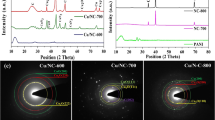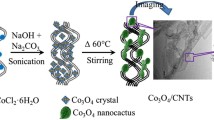Abstract
Recently, the synthesis of nonprecious metal catalysts with low cost and high oxygen reduction reaction (ORR) efficiency is paid much attention in field of microbial fuel cells (MFCs). Transition metal oxides (AMn2O4, A = Co、Ni, and Zn) supported on carbon materials such as graphene and carbon nanotube exhibit stronger electroconductivity and more active sites comparing to bare AMn2O4. Herein, we demonstrate an easy operating Hummer’s method to functionalize carbon nanotubes (CNTs) with poly (diallyldimethylammonium chloride) in order to achieve effective loading of CoMn2O4 nanoparticles, named CoMn2O4/PDDA-CNTs (CMODT). After solvothermal treatment, nanoscale CoMn2O4 particles (~ 80 nm) were successfully attached on the noncovalent functionalized carbon nanotube. Results show that such composites possess an outstanding electrocatalytic activity towards ORR comparable to the commercial Pt/C catalyst in neutral media. Electrochemical detections as cyclic voltammogram (CV) and rotating ring-disk electrode tests (RRDE) showed that the potential of oxygen reduction peak of 30% CMODT was at − 0.3 V (vs Ag/AgCl), onset potential was at + 0.4 V. Among them, 30% CMODT composite appeared the best candidate of oxygen reduction via 3.9 electron transfer pathway. When 30% CMODT composite was utilized as cathode catalyst in air cathode MFC, the reactor obtained 1020 mW m−2 of the highest maximum power density and 0.781 V of open circuit voltage. The excellent activity and low cost (0.2 $ g−1) of the hybrid materials demonstrate the potential of transition metal oxide/carbon as effective cathode ORR catalyst for microbial fuel cells.

ᅟ






Similar content being viewed by others
References
Antolini E (2016) Structural parameters of supported fuel cell catalysts: the effect of particle size, inter-particle distance and metal loading on catalytic activity and fuel cell performance. Appl Catal B Environ 181:298–313
Bin D, Ren FF, Wang Y, Zhai CY, Wang CQ, Guo J, Yang P, Du YK (2015) Pd-nanoparticle-supported, PDDA-functionalized graphene as a promising catalyst for alcohol oxidation. Chem Asian J 10:667–673
Ci SQ, Cai PW, Wen ZH, Li JH (2015) Graphene-based electrode materials for microbial fuel cells. Sci China Mater 58:496–509
Du J, Chen CC, Cheng FY, Chen J (2015) Rapid synthesis and efficient electrocatalytic oxygen reduction/evolution reaction of CoMn2O4 nanodots supported on graphene. Inorg Chem 54:5467–5474
Erable B, Féron D, Bergel A (2012) Microbial catalysis of the oxygen reduction reaction for microbial fuel cells: a review. ChemSusChem 5:975–987
Feng LY, Yan YY, Chen YG, Wang LJ (2011) Nitrogen-doped carbon nanotubes as efficient and durable metal-free cathodic catalysts for oxygen reduction in microbial fuel cells. Energy Environ Sci 4:1892–1899
Gadhamshetty V, Koratkar N (2012) Nano-engineered biocatalyst-electrode structures for next generation microbial fuel cells. Nano Energy 1:3–5
Huang JJ, Zhu N, Yang TT, Zhang TP, Wu PX, Dang Z (2015) Nickel oxide and carbon nanotube composite (NiO/CNT) as a novel cathode non-precious metal catalyst in microbial fuel cells. Biosens Bioelectron 72:332–339
Kang BT, Lee JY (2014) Graphynes as promising cathode material of fuel cell: improvement of oxygen reduction efficiency. J Phys Chem C 118:12035–12040
Kaur P, Shin MS, Sharma N, Kaur N, Joshi A, Chae SR, Park JS, Kang MS, Sekhon SS (2015) Non-covalent functionalization of graphene with poly (diallyl dimethylammonium) chloride: effect of a non-ionic surfactant. Int J Hydrog Energy 40:1541–1547
Kemnade N, Shearer CJ, Dieterle DJ, Cherevan AS, Gebhardt P, Wilde G, Eder D (2015) Non-destructive functionalisation for atomic layer deposition of metal oxides on carbon nanotubes: effect of linking agents and defects. Nano 7:3028–3034
Kim BH, Park HS, Kim HJ, Kim GT, Chang IS, Lee J, Phung NT (2004) Enrichment of microbial community generating electricity using a fuel-cell-type electrochemical cell. Appl Microbiol Biotechnol 63:672–681
Kim JY, Oh TK, Shin YS, Bonnett J, Weil KS (2011) A novel non-platinum group electrocatalyst for PEM fuel cell application. Int J Hydrog Energy 36:4557–4564
Krishnaraj RN, Berchmans S, Pal P (2015) The three-compartment microbial fuel cell: a new sustainable approach to bioelectricity generation from lignocellulosic biomass. Cellulose 22:655–662. https://doi.org/10.1007/s10570-014-0463-4
Li SZ, Hu YY, Xu Q, Sun J, Hou B, Zhang TP (2012) Iron-and nitrogen-functionalized graphene as a non-precious metal catalyst for enhanced oxygen reduction in an air-cathode microbial fuel cell. J Power Sources 213:265–269
Liang YY, Wang HL, Diao P, Chang W, Hong GS, Li YG (2012) Oxygen reduction electrocatalyst based on strongly coupled cobalt oxide nanocrystals and carbon nanotubes. J Am Chem Soc 134:15849–15857
Liu H, Logan BE (2004) Electricity generation using an air-cathode single chamber microbial fuel cell in the presence and absence of a proton exchange membrane. Environ Sci Technol 38:4040–4046
Liu Q, Zhou Y, Chen SL, Wang ZJ, Hou HQ, Zhao P (2015a) Cellulose-derived nitrogen and phosphorus dual-doped carbon as high performance oxygen reduction catalyst in microbial fuel cell. J Power Sources 273:1189–1193
Liu RL, Wu DQ, Feng XL, Müllen K (2010) Nitrogen-doped ordered mesoporous graphitic arrays with high electrocatalytic activity for oxygen reduction. Angew Chemie 122:2619–2623
Liu Y, Ishihara A, Mitsushima S, Kamiya N, Ota K (2005) Zirconium oxide for PEFC cathodes. Electrochem Solid State Lett 8:A400–A402
Liu Y, Jin XJ, Dionysiou DD, Liu H, Huang YM (2015b) Homogeneous deposition-assisted synthesis of iron-nitrogen composites on graphene as highly efficient non-precious metal electrocatalysts for microbial fuel cell power generation. J Power Sources 278:773–781
Logan BE, Hamelers B, Rozendal R, Schröder U, Keller J, Freguia S, Aelterman P, Verstraete W, Rabaey K (2006) Microbial fuel cells: methodology and technology. Environ Sci Technol 40:5181–5192
Miroliaei MR, Samimi A, Mohebbi-Kalhori D, Khorram M, Qasemi A (2015) Competition between E. coli and Shewanella sp. for electricity generation in air cathode MFC in presence of methylene blue as artificial mediator. Environ Prog Sustain Energy 34:1097–1105
Moon JM, Kondaveeti S, Lee TH, Song YC, Min B (2015) Minimum interspatial electrode spacing to optimize air-cathode microbial fuel cell operation with a membrane electrode assembly. Bioelectrochemistry 106:263–267
Ominde N, Bartlett N, Yang XQ, Qu DY (2010) Investigation of the oxygen reduction reaction on the carbon electrodes loaded with MnO 2 catalyst. J Power Sources 195:3984–3989
Papaharalabos G, Greenman J, Melhuish C, Santoro C, Cristiani P, Li B, Ieropoulos I (2013) Increased power output from micro porous layer (MPL) cathode microbial fuel cells (MFC). Int J Hydrog Energy 38:11552–11558
Perelshtein I, Lipovsky A, Perkas N, Gedanken A, Moschini E, Mantecca P (2015) The influence of the crystalline nature of nano-metal oxides on their antibacterial and toxicity properties. Nano Res 8:695–707
Ponce J, Rehspringer JL, Poillerat G, Gautier JL (2001) Electrochemical study of nickel–aluminium–manganese spinel NixAl1−xMn2O4. Electrocatalytical properties for the oxygen evolution reaction and oxygen reduction reaction in alkaline media. Electrochim Acta 46:3373–3380
Pu LT, Li KX, Chen ZH, Zhang P, Zhang X, Fu Z (2014) Silver electrodeposition on the activated carbon air cathode for performance improvement in microbial fuel cells. J Power Sources 268:476–481
Rabaey K, Lissens G, Siciliano SD, Verstraete W (2003) A microbial fuel cell capable of converting glucose to electricity at high rate and efficiency. Biotechnol Lett 25:1531–1535
Roh SH, Woo HG (2015) Carbon nanotube composite electrode coated with polypyrrole for microbial fuel cell application. J Nanosci Nanotechnol 15:484–487
Wang L, Zhao X, Lu YH, Xu MW, Zhang DW, Ruoff RS, Stevenson KJ, Goodenough JB (2011) CoMn2O4 spinel nanoparticles grown on graphene as bifunctional catalyst for lithium-air batteries. J Electrochem Soc 158:A1379–A1382
Wang XY, Yue XH, Guo QJ (2015) Production of electricity during wastewater treatment using fluidized bed microbial fuel cells. Chem Eng Technol 37:703–708
Yoo KS, Park HS, Song YC, Woo JH, Lee CY, Chung JW (2012) The effects of conductivity and CNT cathode on electricity generation in air-cathode microbial fuel cell. J Korean Soc Water Wastewater 26:355–360
You SJ, Zhao QL, Zhang JN, Jiang JQ, Wan CL, Du MA, Zhao SQ (2007) A graphite-granule membrane-less tubular air-cathode microbial fuel cell for power generation under continuously operational conditions. J Power Sources 173:172–177
Yuan HY, Hou Y, Wen ZH, Guo XR, Chen JH, He Z (2015) Porous carbon nanosheets codoped with nitrogen and sulfur for oxygen reduction reaction in microbial fuel cells. ACS Appl Mater Interfaces 7:18672–18678
Zhai XM, Yang W, Li MY, Lv GQ, Liu JP, Zhang XL (2013) Noncovalent hybrid of CoMn2O4 spinel nanocrystals and poly (diallyldimethylammonium chloride) functionalized carbon nanotubes as efficient electrocatalysts for oxygen reduction reaction. Carbon 65:277–286
Zhang P, Li KX, Liu XH (2014) Carnation-like MnO2 modified activated carbon air cathode improve power generation in microbial fuel cells. J Power Sources 264:248–253
Zhang Y, Sun J, Hu Y, Li SZ (2013) Carbon nanotube-coated stainless steel mesh for enhanced oxygen reduction in biocathode microbial fuel cells. J Power Sources 239:169–174
Zhu CZ, Dong SJ (2013) Synthesis of graphene-supported noble metal hybrid nanostructures and their applications as advanced electrocatalysts for fuel cells. Nano 5:10765–10775
Zhu NW, Huang JJ, Shen WH, Tu LX, Wu PX, Ma HQ (2015) Carboxylic carbon nanotube: catalyst support material and oxygen reduction reaction of microbial fuel cells. Int J Electrochem Sci 10:2634–2645
Acknowledgements
The authors would like to thank National Natural Science Foundation of China (30800796 and 31272482), Program for New Century Excellent Talents in University (NCET-11-0166), the Fundamental Research Funds for the Central Universities (2017PY012), Guangdong Provincial Science and Technology Project (2017A020216013), and Guangzhou Science and Technology Project (201604020055) for financial support.
Author information
Authors and Affiliations
Corresponding authors
Ethics declarations
Conflict of interest
The authors declare that they have no conflict of interest.
Electronic supplementary material
ESM 1
(DOCX 111 kb)
Rights and permissions
About this article
Cite this article
Zhu, N., Lu, Y., Liu, B. et al. CoMn2O4-supported functionalized carbon nanotube: efficient catalyst for oxygen reduction in microbial fuel cells. J Nanopart Res 19, 331 (2017). https://doi.org/10.1007/s11051-017-4023-3
Received:
Accepted:
Published:
DOI: https://doi.org/10.1007/s11051-017-4023-3




